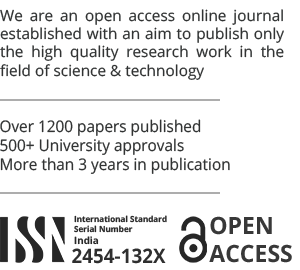Research Paper
An automated prediction system for academic performance
Published by: Shahina K. M.
Full Details
Research Paper
Hybrid secured data retrieval disruption tolerant network
Published by: Noorisaba Sheikh
Full Details
Research Paper
Design of Arduino driven gearbox
Published by: Shravan Anil Shinde, Pranit Narayan Nayyar
Full Details
Research Paper
Radiation analysis in human brain and skull exposed at 915 MHz, 1900 MHz and 2450 MHz frequencies and radiation minimization methods
Published by: Pragati Sharma, Dr. Gulzar Ahmed, Dr. A. K. Gautam
Full Details
Review Paper
Efficiency of using functionalized mesoporous silica-based composites in organic textile dyes removal from aqueous media: Review
Published by: Parviz Azimov
Full Details
Research Paper
Lean manufacturing of NI-MO powder from piston rings plasma spray coating process
Published by: Vadivel M., Sanjay V., Manikanda Yuvaraj G.
Full Details
